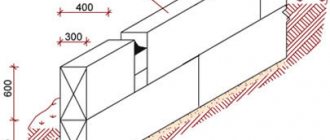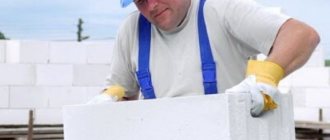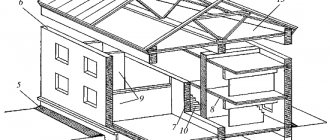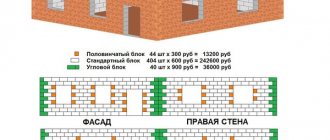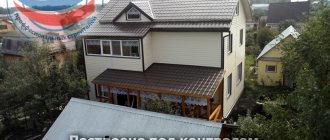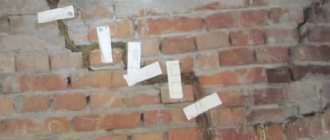Why is it necessary to level the land?
In most cases, the ground cover does not have a level surface. Many who own a country house or garden think about how to level the plot when they want to lay out a lawn or make a summer lawn for a picnic. But this is far from the only reason to give your site a smooth, even surface.
It is usually necessary to level the territory in three cases:
- During capital construction;
- When improving the territory, arranging paths;
- For gardening and gardening.
Any modern capital construction requires that the load on the foundation be distributed as evenly as possible. If a pile or strip foundation is used, the condition of a level building site is most important; the height difference should not be more than 50-60 centimeters. If you are building a house on a monolithic foundation, the presence of unevenness and height differences on the surface of the earth are not so significant.
When the house has already been built on the dacha plot, all the necessary engineering and infrastructure facilities are installed and functioning, it’s time to equip pedestrian paths or improve recreation areas. A sidewalk around the house protects the foundation from the seasonal lateral pressure of the soil layer. At the very beginning of spring, the load reaches peak values, the soil freezes and increases in volume. It is much easier to concrete or tile a flat surface of the ground than one that has uneven surfaces and slopes, and the result will be of better quality.
In the third case, when it is planned to use the land for gardening, if the unevenness does not provide shade on the beds, the result of growing fruit and vegetable crops does not depend on the topography of the fertile layer. But planting, caring for and harvesting crops is much easier and more efficient on a flat surface. Watering plants becomes more economical.
If you decide to arrange a real lawn, you should think about how to level the area. A smooth surface is needed for several reasons:
- Aesthetics – a green, leveled lawn looks much more impressive than one with holes and hillocks
- On flat terrain, lawn mixtures take root better and faster
- Water may remain in the holes for a long time after watering or rain. With prolonged exposure to moisture, the lawn becomes “soaked” and begins to deteriorate. High humidity becomes a beneficial environment for the development of life of simple organisms and insects - woodlice, worms
- Hillocks and protrusions make it difficult to quickly and efficiently mow the lawn with either a wheeled lawn mower or a hand trimmer.
A leveled piece of land is convenient for decoration. Many housewives want to decorate their garden with design solutions in the form of a pond, winter garden, or alpine slide. For any, even the most modest landscape design, you need a prepared, flat surface. The recently fashionable rock garden can only be beautifully created on a smooth area.
Site preparation
After determining the size and type of foundation, you should begin to prepare the site. We remove a layer of soil to a depth of about 20 cm. Carefully level the resulting area. Using a tape measure, a right triangle, pegs and string, you need to transfer all dimensions to the area according to the house plan. It is correct to start this work from the outer walls. Mark the corners with pegs. Then all sizes are checked. Be sure to measure the diagonals - their length should be the same. We install poles at a distance of one meter from the pegs, and nail boards to them to a height of about 80 cm from ground level. We stretch the rope between these boards so that it runs through the center of the future foundation. We mark the internal walls and begin to dig a trench. When the trench is ready, the formwork and reinforcing belt are installed and you can start pouring the foundation.
The foundation must be started immediately after digging the trench, as soil shedding is possible.
Marking technology
To correctly mark the area for a future flat surface, use a construction level, pegs and a marking thread with great strength. The area that is being leveled is marked with pegs into equal zones, if necessary, marking all extreme points - the highest and lowest points of the surface. By eye or using a construction calculator, the required height of the future flat surface of the earth is calculated. The resulting height is fixed with pegs in all previously designated zones, and a marking thread is pulled along the guides. Afterwards, the marking grid is checked again using a level or a building level - the marking is ready.
marking the area for leveling
How to order site leveling
Contact the representative and provide details of the upcoming work: area and location of the site, nature of the soil, whether delivery or removal of the soil will be required. The consultant will tell you when it is best to level the area and how to choose the most suitable work format.
Price for land leveling
| Plot area, acres | Price for leveling a lawn (plow + level - without collecting weeds) | Cost of leveling with a tractor (leveling) | Leveling with backfill (raise by 20cm)*, rub. |
| until 6 | from 22 000 | from 29 000 | — |
| 8 | from 27 000 | from 30 000 | from 70 000 |
| 10 | from 36 000 | from 31 000 | from 85 000 |
| 12 | from 38 000 | from 38 000 | from 100,000 |
| 15 | from 57 500 | from 47 000 | from 120,000 |
| 20 | from 70 000 | from 51 000 | from 180,000 |
Leave a request
If necessary, an engineer comes to the land plot. An on-site specialist draws up a work plan, selects equipment, calculates the volume of material and prepares the work process so that there is no downtime during excavation work.
Call and find out how much it costs to level a site for a foundation, for building a house, with land delivery, using one or more pieces of equipment. Get detailed information about how to complete the task, order turnkey leveling of the site or equipment to perform basic work. Our specialists level it professionally, no alterations are required.
Alignment methods
There are three main options for leveling the area:
- Fill the excavations and hollows with earth to the same level;
- Remove the top layer of soil to the lowest point of the site;
- A combined option consisting of the first two points.
The third option is often the most economical and less labor-intensive. But do not forget that the site is being leveled for specific purposes, where at the planning and design stage the altitude level at which the ground surface should be leveled should already be determined. Sometimes it is necessary to deliberately raise the soil level in order to avoid the accumulation of wastewater from neighboring areas; in some cases, on the contrary, it is necessary to remove as much soil as possible, for example, if the future building is planned to be built on a hill, and the surrounding area is a slope.
Leveling the area with a mini tractor:
Mechanically, the area is leveled using special equipment: at the roughing stage, work is carried out with an excavator, then the earth is compacted with a roller; if the area is small, an industrial vibrating plate is sufficient. After completing the work on a level area, you can continue construction work, load construction materials and drive the truck through.
Site leveling technologies in the Moscow region
Any leveling and planning of a site begins with an analysis of the territory and drawing up a project. The engineer evaluates the landscape, determines how to work with the soil, and selects equipment for leveling the site. Different machines are suitable for each case: sometimes a radical intervention in the landscape is required, sometimes only “cosmetic” leveling of areas and surface cultivation of the ground are required.
Standard set of actions when leveling a territory:
- Leveling a site with a slope. In this case, there are 3 options for completing the task: We process the area along the center line. To level an area on a slope, the soil is moved from the elevated part to the lowland - in this way it is possible to obtain a flat area using the available material.
- Before leveling, fill the area along the upper level. The lower part is raised using imported leveling soil. Leveling the site with backfill helps to raise the level, get rid of the problem with high groundwater, and come to the same level as the road and the neighboring site.
- We cut off the area along the lower level. The upper part of the site is cut off and excess soil is removed.
Price for land leveling
| Plot area, acres | Price for leveling a lawn (plow + level - without collecting weeds) | Cost of leveling with a tractor (leveling) | Leveling with backfill (raise by 20cm)*, rub. |
| until 6 | from 22 000 | from 29 000 | — |
| 8 | from 27 000 | from 30 000 | from 70 000 |
| 10 | from 36 000 | from 31 000 | from 85 000 |
| 12 | from 38 000 | from 38 000 | from 100,000 |
| 15 | from 57 500 | from 47 000 | from 120,000 |
| 20 | from 70 000 | from 51 000 | from 180,000 |
Leave a request
90% of areas in the Moscow region have a mixed landscape, with slopes, hills and holes. Therefore, before working on a plot of land, the engineer determines the complexity, selects equipment, and draws up a diagram. With proper preparation, land leveling services in Moscow and the Moscow region are cheaper, the work proceeds quickly, without additional unforeseen expenses.
How to level it yourself (with the help of small mechanization)
If the area is small or there is no way for special equipment to enter it, you can try to level the area yourself. It is advisable if several adult men take on the work, firstly, this will speed up all the rough physical work, and secondly, the result will be more accurate, because more than one pair of eyes will be watching the alignment process. It all starts with marking and placing vertical beacons on pegs - in this case, pegs are installed only on elevations and slides. When all the rising points are marked in the area we are working on, we proceed to the second stage - using a construction rod or a pre-selected board with a perfectly flat side, we combine two nearby peaks, the resulting gap between the soil and the flat side of the rule or board is thrown earth and level the top layer. After all the irregularities between the designated peaks are filled in at once, the entire surface of the area on which we worked will be an order of magnitude smoother. If you are not yet satisfied with the result, you need to repeat the markings at high points again and once again fill all the cracks that have formed on the leveled area with earth. Next, you need to compact all the poured earth; instead of an industrial vibrating plate or roller, you can use an old barrel, throwing stones, bricks, concrete mixture or the same earth into it for greater pressure on the ground. You can attach wooden handles to it to make it easier to roll.
How to level a site with a cultivator:
What technique should I use to level the area?
Excavation machines perform 2 functions: to level, they cut off excess soil from areas and transport it to depressions or to a dump. Depending on the scale of the work, one or more types of equipment are used to level the ground on the site:
- Bulldozer. A heavy excavation machine turns any area into a flat area. Used for leveling hills, moving material, layer-by-layer development. To level an area with a bulldozer, the machine performs 3 actions in one pass: removes a layer of soil, moves the material to the required distance, compacts the soil and carries out additional leveling with the back of the blade when moving in reverse.
- Front loader. The technique is used similarly to a bulldozer, but can additionally load excess material onto the side of a dump truck or transport material not on the ground, but in a bucket. Often, leveling a site with a loader and bulldozer begins with cutting off the top fertile layer in order to preserve it and use it to restore plantings.
- Scraper. A self-propelled machine or trailed device that removes an even layer of soil and then distributes it in the desired location on the site. The thickness of the layer removed and distributed over the area is adjustable. Scrapers are used for large-scale excavation of soil, preparation of summer cottages, areas for construction sites, parking lots, and highways.
- Motor grader. For leveling, it distributes the soil throughout the site using a special blade on a frame. The tool is capable of working at different angles, effectively leveling the soil when forming sites and access roads.
In addition to the basic equipment, additional tools are often used to prepare the soil and area for leveling. To loosen the soil on the site, it is possible to use hydraulic hammers, the explosive method, and special devices. When correcting complex terrain, the area is first leveled with an excavator. Trucks and loading machines are used to deliver and remove soil.
What is a retaining wall and what is it for?
If your plot of land for construction is not only uneven and has large holes and depressions, but has a slope along the entire length of at least one side, it is necessary to build a retaining wall from durable building materials used in capital construction that are not afraid of moisture. It can be brick, reinforced concrete, natural stone, building blocks set on cement-sand mortar. A retaining wall is erected in the place where a large difference in height is planned, more than 30-40 centimeters; it prevents the soil from crumbling and prevents it from being washed away by groundwater in the off-season.
Video about retaining walls:

